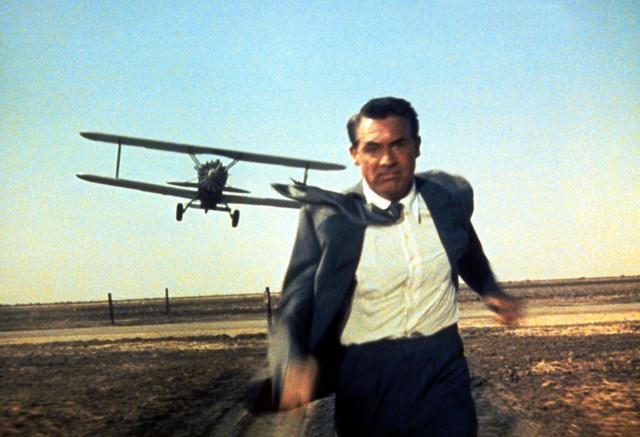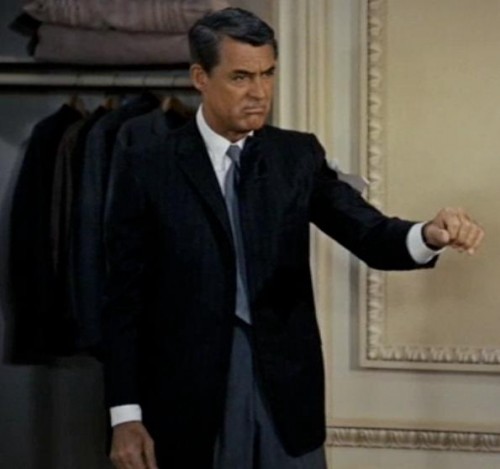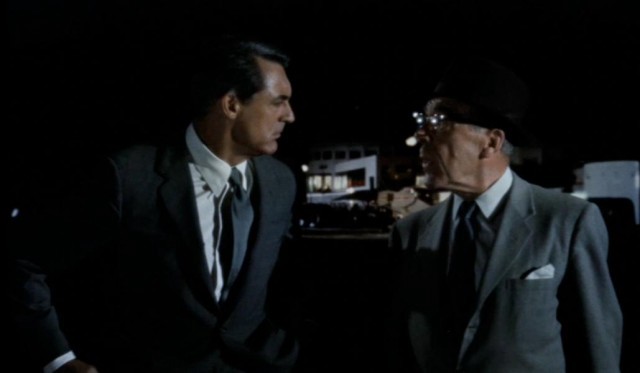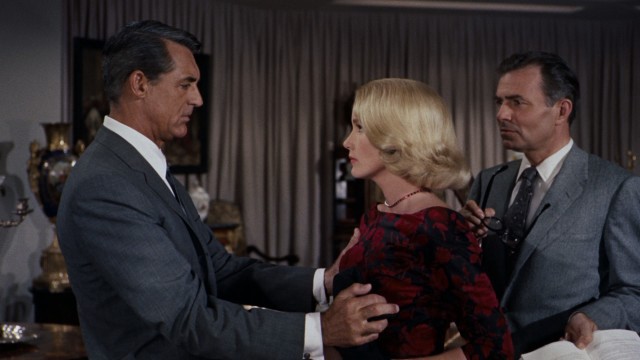The One Edit That Would Make 'North By Northwest' Perfect
by Josh Fruhlinger

North By Northwest is fantastic. Can we agree on this? I hope so. If you disagree, you’re probably a perfectly nice person, but I’m afraid you are factually incorrect on this point, and I’m not going to deign to argue with you. Sorry. “Propulsive” is a word that has been beaten to death by movie critics, but really, the plot gets underway immediately — Cary Grant is kidnapped less than four minutes after the opening credit sequence ends — and does not really let up for the next two wonderful hours.
As the Oscars draw near,
the first in a series about our strong movie opinions, past and present.
Because North By Northwest is so fantastic, I have seen it many times. I try to see it whenever a revival is showing at a nearby movie theater, and if I stumble upon it while channel surfing (something that happens more often than you’d think to a guy who doesn’t have cable) I invariably watch it to the end. Which means I’ve thought about the movie a lot. Now, this next sentence should not be read as me backing off one iota from my earlier assertion that the movie is fantastic and you are wrong if you disagree, but I’ve wondered: could it be made even better, by someone moderately more skilled with video editing software than I am? Over my twenty years or so of not infrequent North By Northwest watching, I have developed a theory that it could. Beware: If you somehow have gotten to 2013 and haven’t seen this movie but still want its surprises fresh for you when you finally get around to seeing it, spoilers follow from here. Ironically, I need to talk about the spoilers to talk about my theory, which involves removing spoilers from the movie itself.
The plot is based on one of Hitchcock’s favorite gimmicks: the ordinary man thrust into dangerous and exciting circumstances due to a case of mistaken identity. In this case, Roger Thornhill (Cary Grant, exasperated wit) is kidnapped by and almost killed by the henchmen of Philip Vandamm (James Mason, languorous creep). Vandamm’s crew all insist that Thornhill is actually someone named George Kaplan. For the first forty minutes or so of the movie, while Thornhill isn’t busy trying to keep from getting killed, he’s trying to figure out who the real George Kaplan is. One of the great joys of the movie is watching Roger Thornhill, in his attempt to prove he isn’t George Kaplan, pretend to be George Kaplan. There’s a sequence where Thornhill and his mother bluff their way into the absent Kaplan’s hotel room, checking out his bathroom (dandruff shampoo) and trying on his suit (too small). The film’s opening act ends with Thornhill fleeing after a dead body lands in his arms in the middle of the U.N. building.

Immediately afterwards comes what is undoubtedly the worst, most awful scene in a great movie. After forty minutes of non-stop action, everything suddenly grinds to a halt so that we can be treated to some exposition down at CIA headquarters, delivered in the worst possible format: a bunch of people, none of whom we’ve seen before, sitting around a conference table telling each other things they already know. The scene’s only three minutes long, but it seems to last forever.

Anyway, as we learn, the deal with George Kaplan is that he doesn’t exist. The spymasters are renting hotel rooms in his name and leaving prop belongings in them in all the cities where Vandamm is going, because they want him to believe that he’s being tailed by a spy named George Kaplan. Focused on this elusive secret agent, Vandamm won’t suspect the “actual agent” who’s “working under Vandamm’s very nose.” The dialogue withholds this spy’s identity as artificially as it reveals everything else, but it does at least leave one mystery for us.
After this blah-blah ends, we cut back to Thornhill, who’s managed to escape from the U.N. to Grand Central Terminal. He gets on the 20th Century Limited, and in short order, is hidden away from the cops by Eve Kendall (Eva Marie Saint), has sex with Eve Kendall, and is sent off to be killed by Eve Kendall, who turns out to be Vandamm’s girlfriend. Surviving the attempt, he doubles back, finds the plotters, berates them at an art auction, then gets himself arrested because he’s finally decided he’ll be safest with the cops; the cops then hustle him to the airport and hand him over to the Professor (Leo Carroll), one of the spooks from the earlier terrible exposition scene.


This all takes another 55 minutes or so, and it’s 55 minutes that loses some of the immediacy of the first act, because, while we’re watching Thornhill pursue Kaplan, we know that Kaplan doesn’t exist. We’re treated to a different and, of course, perfectly respectable sort of dramatic tension — not so much “What will happen?” as “When will he learn what is happening?” — but it causes a bit of a downshift in intensity nonetheless. The Professor finally reveals what’s been happening to Thornhill as they cross the tarmac to get on a plane headed for South Dakota; most of the information that would be a straight-up repeat of exposition from the earlier scene is drowned out by the plane’s propellers, a touch I have always assumed to be intentionally hilarious. (We also lean that Eve Kendall is the real American secret agent; the rest of the movie involves rescuing her from Vandamm’s clutches.)

These two sections of exposition break the film into three acts, and the levels of knowledge held by the audience and protagonist are structured differently in each. To start, we and Thornhill are equally in the dark; then in the middle, we know the crucial data that he doesn’t; and finally, everyone knows everything and we’re ready to confront the bad guy together. While this is interesting formally, I (along with Eve Kendall) believe that being the dark with Roger Thornhill as long as possible is more fun.
And, tantalizingly, such a version of the film is within our reach. The first, and most obvious step, is to cut out that early terrible scene at Boring Spy HQ entirely. Just cut it! There are plenty of fascinating and hilarious minor characters in the movie who only get one or two lines, but none of them are in that scene. The only one we ever see again is the Professor, and he has to re-introduce himself to Thornhill when they meet anyway. A bit before his reappearance, the Professor pops up in the crowd at the art auction scene. The camera lingers on him now and again, to remind you that you know who he is, but if you didn’t, it wouldn’t make the scene weird, and it would create a moment of recognition when you meet him a few minutes later.
But we do need some of the information in that first exposition scene, right? Yes, but less than you might think. Much of the dialogue there rehashes the plot up to that point, and much of what we do need to know is repeated in the audible parts of the airport scene. The rest could be packed into a couple of sentences, like:
“We created George Kaplan, established elaborate behavior patterns for him, moved his prop belongings in and out of hotel rooms, labored successfully to convinced Vandamm that this was our own agent hot on his trail. If we make the slightest move to suggest that there is no such agent as George Kaplan — give any hint to Vandamm that he’s persuing a decoy instead of our own agent, then our agent, working right under Vandamm’s very nose will immediately face suspicions.”
Fortunately for us, the Professor says those very words (though not quite in that order) in the first exposition scene, and someone with more video editing skills than me could perhaps just drop them into propeller-fuzzed section of the airport scene And then, ta-da! A great movie gets even greater.
Hitchcock famously popularized the term “MacGuffin” to refer to an object that motivates the characters but that the audience doesn’t really care about. In North By Northwest, the MacGuffin is a tiny pre-Columbian statue with microfilm in its gut that Vandamm is going to take with him to Russia. It’s such an advanced version of its type that the viewer barely even thinks about it.
If there’s a mystery we care about, it’s George Kaplan. There are moments when he seems within our grasp — when Thornhill tries on his suit, when Kendall says she’s talked to him on the phone. Perversely, finding out that he was never there is delightfully satisfying. I just think it’d be even more delightful if we had to wait another hour or so to find out.
Hitchock-related: How To Get Your Lion Back When It Runs Away: Life Lessons From Tippi Hedren
Josh Fruhlinger thinks the trout is a little trouty. Follow him on Twitter or Tumblr.
